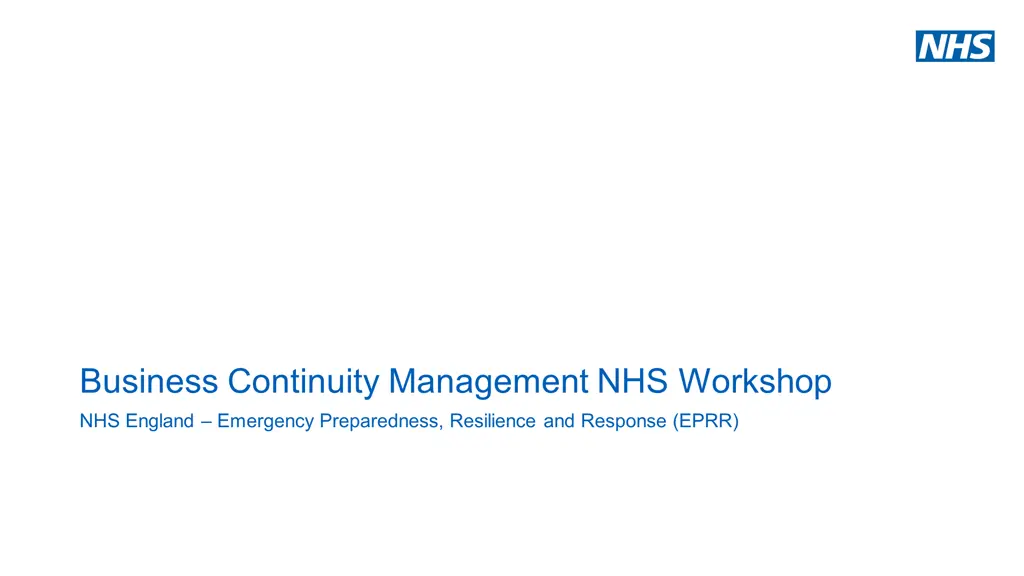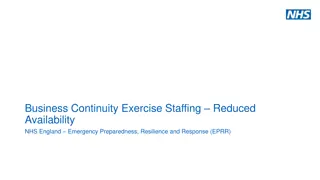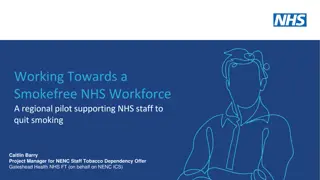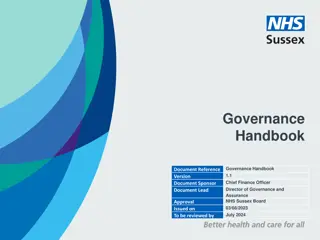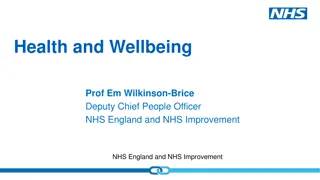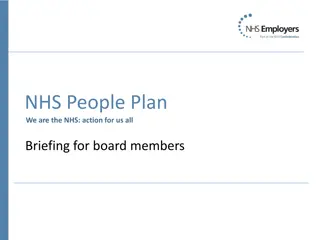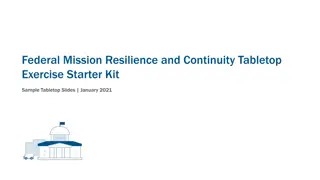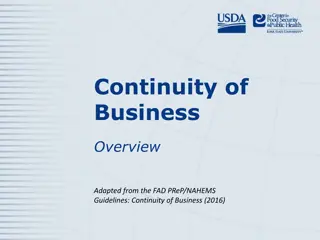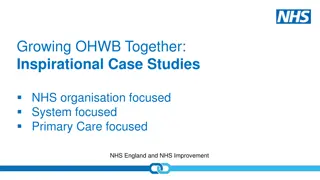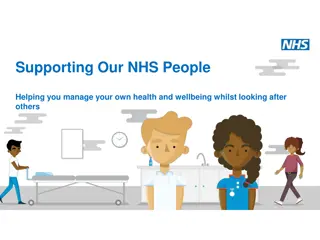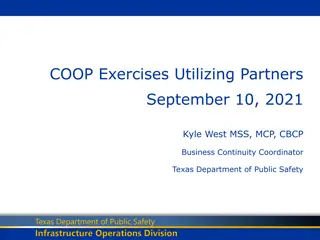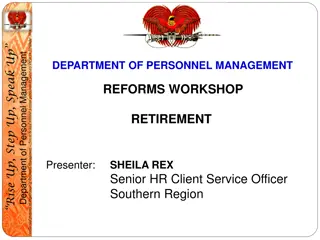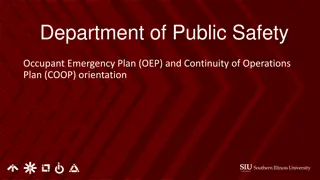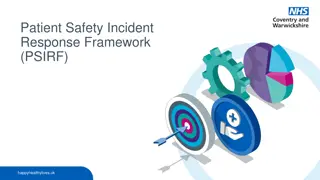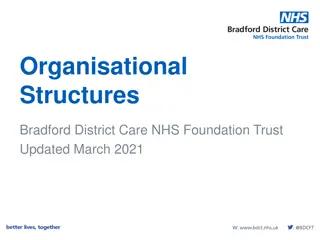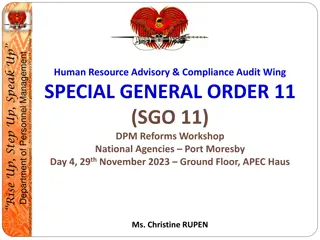Business Continuity Management NHS Workshop
The NHS England Emergency Preparedness, Resilience, and Response workshop to learn about implementing a BCMS in your organization.
Download Presentation

Please find below an Image/Link to download the presentation.
The content on the website is provided AS IS for your information and personal use only. It may not be sold, licensed, or shared on other websites without obtaining consent from the author. Download presentation by click this link. If you encounter any issues during the download, it is possible that the publisher has removed the file from their server.
E N D
Presentation Transcript
Business Continuity Management NHS Workshop NHS England Emergency Preparedness, Resilience and Response (EPRR)
House Keeping Fire Safety Breaks and Refreshments Toilets Mobiles/Electronic Devices 2 |
Introduction Respect and value each others contributions . What is said in the room stays in the room Share your experiences to add value to the workshop 3 |
Aim and Objectives Aim To develop an understanding of how to implement a BCMS within your organisation. Objectives To develop an understanding of business continuity. To understand how to use the business continuity toolkit. To understand how to undertake a business impact analysis for your organisation To understand how to develop a business continuity plan for your organisation 4 |
Ice Breaker Tell the group: Your name Your role and department you work in What role you have in business continuity Have you ever been involved in responding to a business continuity incident What do you know about business continuity? Favourite sweet you had when you were growing up! 5 |
Definitions ISO 22301:2019 Business Continuity The capability of the organisation to continue delivery of products or services at acceptable predefined levels following a disruptive incident. Business Continuity Management A holistic management process that identifies potential threats to an organisation and the impacts to business operations those threats, if realized, might cause, and which provides a framework for building organisational resilience with the capability of an effective response that safeguards the interests of its key stakeholders, reputation, brand and value- creating activities. Business continuity management system Part of the overall management system that establishes, implements, operates, monitors, reviews, maintains and improves business continuity. 6 |
Business Continuity Management System ISO 22301/22313 A business continuity management system emphasises the importance of Understanding the organisation s needs and the necessity for establishing a business continuity management policy and objectives Implementing and operating controls and measures for managing an organisation s overall capability to manage disruptive incidents Monitoring and reviewing the performance and effectiveness of BCMS, and Continual improvement based on management of objectives 7 |
Elements of Business Continuity Management Business impact analysis and risk assessment Operational planning and control Business Continuity Strategy/ Leadership Exercising and Testing ISO22313 Establish and implement BC procedures 8 |
Plan, Do, Check, Act Cycle The ISO 22301 and 22313 uses a Plan, Do, Check, Act cycle in planning, establishing, implementing, operating, monitoring, reviewing, maintaining and continually improving the effectiveness of an organisations business continuity management system 9 |
Activity 1 In your groups discuss what the legal and/or regulatory responsibilities for business continuity are for your organisation and the wider NHS 11 |
Activity 1- Summary Civil Contingencies Act 2004 and Civil Contingencies Act 2004 (Contingency Planning) Regulations 2005 ISO 22313:2020 and ISO 22301: 2019 NHS England Emergency Preparedness, Resilience and Response Framework last revised 2022 NHS England Business Continuity Framework last revised 2022 Health and Safety at Work etc. Act 1974 NHS Standard Contract 12 |
Activity 1 Summary Continued Apart from the legal side common sense prevails for the: Public we serve The staff we employ Our partners we work with And those who commission our organisation 13 |
Interested Parties Adapted for the NHS from ISO22313 14 |
Elements of Business Continuity Management 1 Business impact analysis and risk assessment Operational planning and control Business Continuity Strategy Exercising and Testing ISO22313 Establish and implement BC procedures 15 |
Business Impact Analysis The BIA identifies business continuity requirements, providing information to determine the most appropriate business continuity solutions. The BIA also identifies the urgency of each activity undertaken by the organisation by assessing the impact over time caused by any potential or actual disruption to this activity on the delivery of products and services. 16 |
Understanding the Organisation Understanding the Organisation Suppliers & Partner Organisations Internal Context External Context Purpose of Organisation Products & Services Products & Services Patients & Clients Products & Services Activity Activity Activity Activity Activity Activity Dependencies and supporting activities Supporting activity Assets and resources Assets and resources Adapted for the NHS from ISO22313 17 |
Business Impact Analysis Template Risk assessment and treatment Prioritisation of activities including recovery time objectives (RTO) and maximum tolerable period of disruption (MTPoD) Identify resources required for maintenance of priority services 18 |
Business Impact Analysis Activities that cannot tolerate any disruption Activities which can tolerate very short periods of disruption Activities which could be scaled down if necessary for short periods of time Activities which could be suspended if necessary Source: ISO 22313 19 |
Activity 2 In your groups: Identify your organisation s/department s essential activity/service Also identify your organisations legislative requirements. What are the resources required to deliver these? Are there any apparent risks to maintaining these prioritised activities? How will you reorganise to maintain these prioritised activities in the event of a disruptive incident? 20 |
Element of Business Continuity Management 2 Business impact analysis and risk assessment Operational planning and control Business Continuity Strategy Exercising and Testing ISO22313 Establish and implement BC procedures 21 |
Business Continuity Strategy Options Stakeholders People Suppliers Premises Information Technology Adapted from PAS 2015 22 |
Activity 3 In your groups discuss: Does your organisation have a business continuity strategy? What do you think a business continuity strategy should contain and why? Who is the organisation s senior business continuity champion? Does your organisation have an agreed essential/priority service list? 23 |
Elements of Business Continuity Management 3 Business impact analysis and risk assessment Operational planning and control Business Continuity Strategy Exercising and Testing Establish and implement BC procedures 24 |
Activity 4 Continuity Requirements Suppliers and Partners People Premises Technology Information 25 |
Activity 4 Continuity Requirements Suppliers and Partners People Premises Technology Information What number of staff do you require to carry out critical activities? What is the minimum staffing level you will need to deliver these? What skills/level of expertise are required to undertake these activities? What locations do your prioritised activities operate from? What alternative premises do you have? What machinery, equipment and other facilities are essential? Is the service dependant on electrical medical equipment? What IT is essential to carry out your prioritised activities? What systems and means of communication are required to carry out your prioritised activities What Information is essential to carry out your prioritised activities? How is this information stored? Who are your priority suppliers? Are key services contracted out? Do both you and your suppliers/ partners have mutual aid arrangements in please? 26 |
Definitions Recovery Time Objective (RTO) A period of time following an incident within which a product or service must be resumed, or activity must be resumed, or resources must be recovered. Maximum Tolerable Period of Disruption (MTPoD) The time it would take for adverse impacts, which might arise as a result of not providing a product/service of performing an activity, to become unacceptable. Source: ISO 22301 27 |
Mitigating Impacts Through Effective Business Continuity: Sudden Disruption ISO22313 28 |
Mitigating Impacts through effective business continuity: Gradual disruption ISO22313 29 |
Incident Timeline What mechanism could be used to ensure that during and following an incident the matter is escalated to the appropriate level in the organisation? What are your organisational command and control arrangements? 30 |
Activity 5 List as many examples as you can of measures which could be considered in the context of flooding due to failure of internal plumbing systems to: Reduce the likelihood of a disruption Shorten any period of disruption Limit the impact of a disruption 31 |
Example NHS staff strikes NHS staff strikes in 2013 and 2014, Junior Doctors in 2016 Disputes over staff pay The strikes were the first by NHS staff over pay in more than 30 years 33 |
Example Severe Weather (Storms) During the winter of 2021/22 the UK had experienced 5 storms. 1. Storm Malik 28/01/22 2. Storm Corrie 29/01/22 3. Storm Dudley 14/02/22 4. Storm Eunice 18/02/22 5. Storm Franklin 21/02/22 The NHS experienced various business continuity issues throughout this period, some of which are mentioned below: Travel disruptions Structural damage impacted NHS Buildings across the country. Outpatient appointments being rescheduled as a result of the severe weather. Roads, bridges and railway lines closed, with delays and cancellations to transport. 34 |
Example Royal Marsden 2008 More than 100 firefighters in 25 fire engines were deployed on the blaze Between 80-90 patients were helped onto the streets whilst the hospital was filled with thick smoke The fire could be seen across the London skyline Further information: http://www.webarchive.org.uk/wayback/archive/20 130304124419/http://www.london.nhs.uk/webfiles /Corporate/NHSL_FIRE_LR_2.pdf 35 |
Example WannaCry Cyber Attack On Friday 12th May 2017, the NHS, was affected by the WannaCry outbreak, affecting hospitals and GP surgeries across England and Scotland. Although the NHS was not specifically targeted, the global cyber-attack highlighted security vulnerabilities and resulted in the cancellation of thousands of appointments and operations, together with the frantic relocation of emergency patients from stricken emergency centres. Staff were also forced to revert to pen and paper and use their own mobiles after the attack affected key systems, including telephones. The WannaCry ransomware exposed a specific Microsoft Windows vulnerability, not an attack on unsupported software. Most of the NHS devices infected with the ransomware, were found to have been running the supported, but unpatched, Microsoft Windows 7 operating system, hence the extremities of the cyber-attack. The ransomware also spread via the internet, including through the N3 network (the broadband network connecting all NHS sites in England), but fortunately, there were no instances of the ransomware spreading via NHSmail (the NHS email system). NHS England reported at least 80 out of the 236 trusts were affected in addition to 603 primary care and other NHS organisations, including 595 GP practices. 36 |
Example BT Flood and Fire March 2010 ...tens of thousands of customers in parts of North and West London may be experiencing a loss of broadband and/or telephone service [...] as this is a complex incident we cannot accurately predict when all services will be restored. We will issue further updates as the situation changes. Any customers needing to make calls to the emergency services who have a problem using their phones are advised to do so by using their mobile phone, or alternatively by using a friend or neighbour's working phone 37 |
Example Coronavirus (COVID 19) What is Coronavirus? Coronavirus, also called COVID-19, is part of a family of viruses that includes the common cold and more serious respiratory illnesses such as SARS. It affects your lungs and airways. For many people, it causes mild symptoms, while for others it can be much more serious and require hospital treatment. Coronavirus is very infectious, which means it spreads very easily. It spreads in much the same way as the common cold or flu through infected respiratory droplets like coughs and sneezes and passes from person to person. On Wednesday 29 2020 the UK s first two patients The average incubation period the time between coming into contact with the virus and experiencing symptoms is 5 days, but it could be anything between 1 and 14 days. As of 21/04/22 there have been over 22 million cases of COVID in the UK and over 173,000 deaths. As of 15/04/22 there have been a total of 831,579 patients who have been admitted to hospital with COVID-19. NHS Impacts Additional pressures in conjunction with winter pressures on emergency departments Staff shortages due to sickness Impact on the availability of PPE Supply Chain disruption Shortage of equipment Mental and physical trauma 38 |
Example Chase Farm Hospital 2010 Loss of water supply due to burst water main in Enfield. Bowsers (water tanks) are still on site to ensure the main patient areas continue to receive water [...] Bottled water is available for staff and patients. The A&E department is open to all walk-in patients however all other emergencies are being transferred to Barnet Hospital. Once the water has resumed A&E services will return to normal. 39 |
Example Grenfell Tower 14thJune 2017 is when a high rise fire broke out in the 24-storey Grenfell Tower block of flats in North Kensington, West London, at 00:54 BST due to an electrical fault in a refrigerator. 74 people died, 70+ People Injured and 223 escaped. Escalated to the external cladding of the building. Mutual aid was in place over a period of time. There was a multi-agency response. NHS Impacts More than 100 London Ambulance Service Crews were on site. At least 20 Ambulances present. London hazardous area response team took part in the response. Casualties were taken to 5 different hospitals. Mental and physical trauma for responding NHS colleagues. Additional pressures on surrounding NHS trusts e.g. Kings College Hospital, Chelsea and Westminster, Royal Free, Guys and St Thomas , St Marys and Charing Cross in conjunction with undertaking BAU activities. Building inspections around cladding for NHS buildings across the country.. 40 |
Activity 6: Business Continuity Strategy Options Discussion What strategies might be needed for maintaining core skills and knowledge? What elements should your premises strategy consider to reduce the impact of the unavailability of one or more worksites? What technology strategies for business continuity could your organisation adopt in the event of a disruption to the main area of your building following a fire, with an recovery time objective of three months? 41 |
Business Continuity Response Plans Organisations may have numerous plans. These may include: Strategic organisational incident response plan Department/service response plans Building or site response plans Technical response plans for IT or clinical systems 42 |
Business Continuity Response Plan Content Document control Purpose and scope Document owner and reviewer Roles and responsibilities Plan activation Contact details Incident management structure and plan Action cards Appendences Training and Exercising 43 |
Business Continuity Response Plan Content The plan should: set out the prioritised activities to be recovered, the timescales in which they are to be recovered and the recovery levels needed detail the resources available at different points in time to deliver the prioritised activities outline the process for mobilising the necessary resources include actions and tasks needed to ensure the continuity and recovery of prioritised activities be stored in a place that s easily accessible e.g. storing on a shared drive or hard copies 44 |
Elements of Business Continuity Management Business impact analysis and risk assessment Operational planning and control Business Continuity Strategy Exercising and Testing Establish and implement BC procedures 45 |
Exercising and Testing Exercises provide an opportunity to test plans in order to assess how our plans would stand up in a disruption Ensures that plans are fit for purpose Identify gaps and learning actions Continuous updating of core information i.e. contact lists 46 |
Types of Business Continuity Exercises It is important for those who are responsible for business continuity to determine which type of business continuity exercise is appropriate based on the desired outcomes. This is because exercises vary in levels and resources required. There are five main types of exercise: Discussion based exercise - These exercises are considered to be the most cost effective and the least time consuming of exercise types. They are commonly structured events where participants can explore relevant issues and walk through plans in an unpressurised environment. This type of exercise can focus on a specific area for improvement that has been identified with the aim being to find a possible solution. Table top exercise - These are commonly used where the discussion is based on a relevant scenario with a time line which may run in real time or may include time jumps to allow different phases of the scenario to be exercised. Participants are expected to be familiar with the plans being exercised and are required to demonstrate how these plans work as the scenario unfolds Command post exercise - These typically involve management teams at a strategic, tactical or operational level. Participants can be located across the whole organization (and could potentially involve willing interested parties), all working from their usual day to day locations. In these exercises, participants are given information in a way that simulates a real incident. Participants can be invited to respond as they would for real, they are expected to deal with the situations that they encounter, linking in to others as necessary Live exercise - These exercises can range from a small scale rehearsal of one component of the response, for example evacuation, through to a full scale rehearsal of the whole organization and potentially participating interested parties. Live exercises are designed to include everyone likely to be involved in that part of the response. Test - A test is a unique and particular type of exercise, which incorporates an expectation of a pass or fail element within the goal or objectives of the exercise being planned. It is usually applied to equipment, recovery procedures or technology, not to individuals. 47 |
Why undertake A Business Continuity Exercise? Exercises are undertaken with three main purposes: Validation - to validate and identify improvement opportunities in existing arrangements Training - to develop staff competencies and confidence by giving them practice in carrying out their roles in an incident Testing - to test existing procedures, plans and systems to ensure they function correctly and offer the degree of protection expected 48 |
Business Continuity Off The Shelf Exercise UK Health Security Agency have developed a business continuity off the shelf exercise. The business continuity off the shelf exercise uses three short scenarios to facilitate the review of local business continuity preparedness plans and enhance organisational resilience in case of disruption to the organisations core functions. To request an off the shelf exercise email exercises@ukhsa.gov.uk 49 |
Embedding Your Business Continuity Plan To embed business continuity within your organisation you must ensure that business continuity plans are: Communicated to staff, as well as the staff having the appropriate experience and skills to deliver their roles. Have buy in and owned by the senior management team. Continually exercised. Version controlled, so the correct plan is being followed. 50 |
